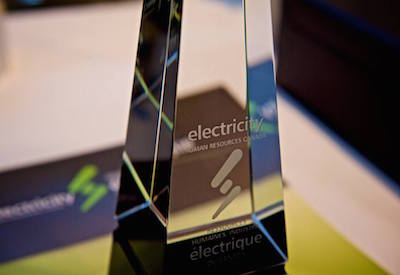Éric Deschênes – Resolutely Focused on the Digital Future

October 6, 2021
By Line Goyette
As the head of ABB Canada’s electrification business unit, Éric Deschênes is no newcomer to the electrical industry. He has a long track record and a passion for finding practical solutions to optimize technology adoption. Deschênes took on his current role with ABB January of 2020, he joined ABB in 2017 as Executive VP of the Electrification business after 15 years with Schneider Electric. We met with him recently to discuss his new role at the helm of ABB Canada and his plans moving forward. He began by pointing out that the recent change to ABB Canada’s structure, as elsewhere in the world, was made to make customer relations more straightforward. “The corporate matrix has been streamlined to get closer to the customer,” says Eric.
Our meeting took place in the ABB offices in Iberville, which until recently bore the Thomas & Betts logo. For Éric Deschênes, this location is more than emblematic, “Thomas & Betts has brought an important signature and culture to ABB that revolves around two axes: the distribution network and the customer-user. These two elements must be at the heart of any process. Even if you offer the best product, if doing business together is difficult, the customer goes elsewhere.” For now, ABB Canada’s new leader is working to build a digital platform where the customer is always at the heart of the process.
The change has begun. The stated goal is to have a differentiating value in the market. “We’re competing today with people who could be in their garage. If an individual offers a product that corresponds to a customer’s need and proposes a new technology, they become a competitor, hence the importance of getting closer to the customer and simplifying daily relationships and business processes,” insists Deschênes and he specifies that this change was initiated under the leadership of Nathalie Pilon. “When she moved from the presidency of T&B to ABB Canada, she sought to have all business units work together in a way that would add value and differentiate ABB. I make it my duty to continue what Nathalie started, and the change will be in continuity,” he says.
A digital shift
At the heart of these changes is the digital revolution, both internally and externally. “We want to offer relevance and added value to the customer. We’re eliminating unnecessarily long bureaucratic steps and replacing them with digital processes and we’re seeing the processing of applications go from 60 to 3 days. We also talk about VMI, online product selectors. We want to be the most efficient partner for our channel partners for standard products, configuration products and engineering products.” Eric continues, “GE’s integration with ABB allows us to offer over 20,000 standard product lines at the Bromont distribution center. Everything is centralized for these products: one order, one shipment, one invoice. When we thought about integrating GE, the question was how to integrate this entity and move forward as a company. We started with the DNA of Thomas & Betts, which is to become the most efficient partner for our distributors, to be the most digital and technical to bring relevance and value to keep the customer at the center of all our processes.”
“The common thread across all business units will be digitization on two levels, internally and externally. Internally, our plants and distribution centers will all be equipped with ABB technology. At the process level, we will reduce unnecessary bureaucracy to a minimum, any manual interaction that adds unnecessary pressure to a transaction will be removed. We will digitize the interactions between people to bring incomparable efficiency, as much as possible. This external digitization is ABB Ability, the digital platform that all business units will implement.”
Projects – Produced and assembled in Canada
In Canada ABB has about 50 buildings, 9 manufacturing and assembly plants and the Bromont distribution center, which for now only has electrification products. “We will create space on the Montreal campus for Bromont to become a distribution center for products from all business units. Our customers are often the same, in automation, electrification or low voltage products. We will migrate our business systems to a single ERP system.
The Bromont distribution center will migrate from Bromont electrification products to Bromont ABB Canada and in the space created at the Montreal campus, 5 production lines for products formerly manufactured in the United States will be brought in, including motor control centers, connection panels and lighting panels. This is an important project for Eric Deschênes. “It will not be an assembly line. The steel will come from Canada, the fabrication will be done in Canada and the final assembly will be done at the Montreal campus. We have successfully tested the first lighting panel that was manufactured in November and shipped to the client, it works. We are in the process of recalibrating everything to reduce costs for all our partners. The Canadian market has 880 distribution points, we have access to 660 distribution points. So, it’s in our interest to simplify and maximize to optimize. It would be a fundamental mistake to ignore the distributor in the way we serve the Canadian market.”
I ask Deschênes about his goals for 2020, which we’ll follow up on in our 2021 interview, he responded this way: “Goal #1 is to make sure we continue the same sustained growth (double digit growth) with the involvement of our employees. They are the ones making the decisions, who are close to the customers. We have confidence in them. My second objective is to accelerate digitalization internally and externally, and the third, which will give us the most pleasure, is the integration of all standard, configurable and engineered products into the manufacturing and assembly processes in Canada.” It’s a date!
Line Goyette is Managing Editor of Kerrwil Publications’ Electrical Group, this article was originally published on Le monde de l’électricité en ligne in March of 2020.

















